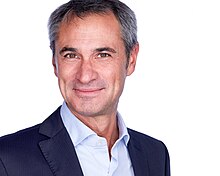Dario Floreano
Dario Floreano | |
|---|---|
 Dario Floreano | |
| Born | Dario Floreano 1964 (age 59–60) |
| Nationality | Swiss and Italian |
| Alma mater | University of Trieste University of Stirling |
| Known for | Evolutionary robotics Bio-Inspired Drones |
| Scientific career | |
| Doctoral students | Sabine Hauert[1] |
| Website | people |
Dario Floreano (San Daniele del Friuli, Italy, 1964) is director of the Laboratory of Intelligent Systems (LIS)[2] at the École Polytechnique Fédérale de Lausanne in Switzerland as well as the Swiss National Centre of Competence in Research (NCCR) Robotics.[3]
Education
Floreano received an M.A. in visual psychophysics from the University of Trieste in 1988, an M.Sc. in neural computation from the University of Stirling in 1992,[citation needed] and a Ph.D. in cognitive systems and robotics from the University of Trieste in 1995.[citation needed]
Career and research
Floreano is interested in biologically inspired artificial intelligence and robots. He made pioneering contributions to Evolutionary Robotics, a research field where robots equipped with artificial neural networks are evolved using artificial evolution;[4] to Autonomous Drones with a series of innovative machines loosely inspired from insects and birds, and to Soft Robotics with the development of multi-functional materials for wearable robots, flying robots, and modular robots. He published hundreds of peer-reviewed articles and four books on neural networks, evolutionary robotics, bio-inspired artificial intelligence, and bio-inspired flying robots.[citation needed]
Floreano co-organized several international conferences in the fields of bio-mimetic engineering and is or has been on the editorial board of several international journals: Neural Networks; Genetic Programming and Evolvable Machines; Adaptive Behavior; Artificial Life; Connection Science; Evolutionary Computation; IEEE Transactions on Evolutionary Computation; Autonomous Robots; Evolutionary Intelligence.[citation needed]
He was co-founder and member of the Board of Directors of the International Society for Artificial Life, Inc., member of the Board of Governors of the International Society for Neural Networks, Advisory Board member of the Future and Emerging Technology division of the European Commission, and founding members and vice-chair of the General Agenda Council on Robotics of the World Economic Forum.[citation needed]
He was also director of the popular podcast series Talking Robots,[5] which featured interviews with high-profile professionals in robotics and artificial intelligence for an inside view on the science, technology, and business of intelligent robotics. His former PhD students and postdocs continued and expanded the podcast, which today is called The Robotics Podcast.[citation needed]
In addition to academic research and teaching, Dario Floreano has spun off two drone companies, senseFly (2009) and Flyability (2014), which continue to set new standards in user-friendly professional drones for inspection, agriculture, and survey. He also delivers high-profile keynotes at international conferences, governmental meetings, and company events. He is particularly interested in exploring the co-evolution of intelligent robots and humans.[citation needed]
References
- ^ Hauert, Sabine (2010). Evolutionary Synthesis of Communication-Based Aerial Swarms. epfl.ch (PhD thesis). Ecole Polytechnique Fédérale de Lausanne. doi:10.5075/epfl-thesis-4900. OCLC 890692372.
{{cite thesis}}: Cite has empty unknown parameter:|1=(help) - ^ Laboratory of Intelligent System
- ^ "NCCR Robotics People".
- ^ Tom Standage (9 June 2017). "Dario Floreano: A pioneer of "evolutionary robotics" borrows drone designs from nature". The Economist. Retrieved 9 June 2017.
- ^ Talking Robots
External links
- Dario Floreano publications indexed by Google Scholar
